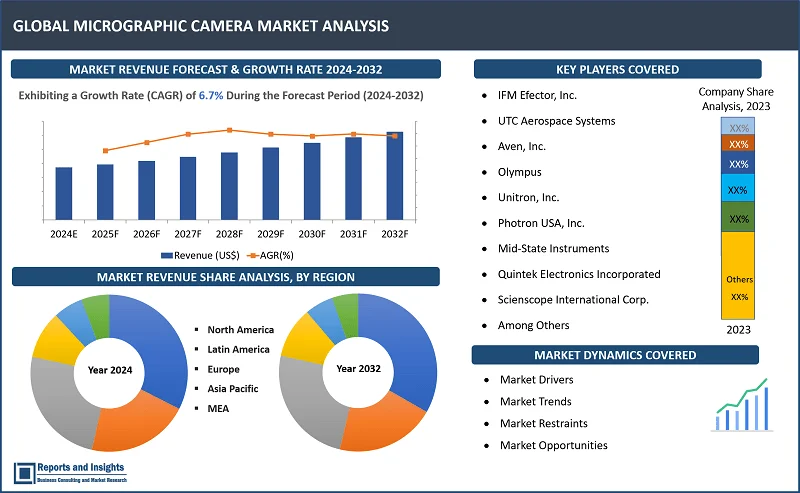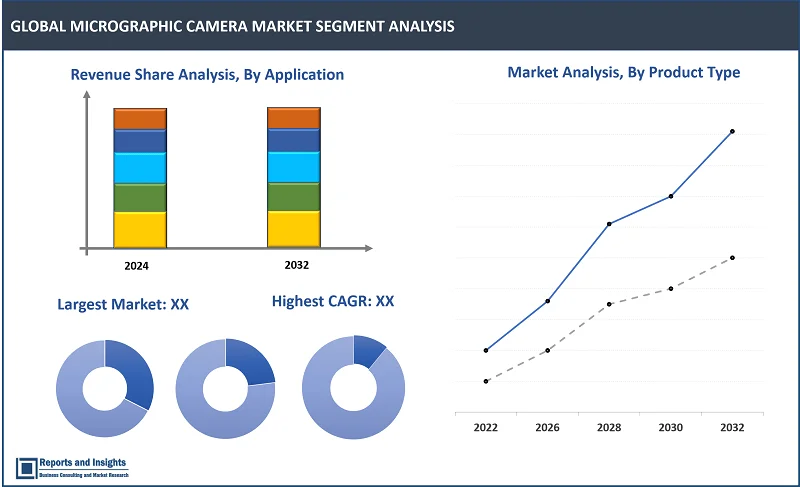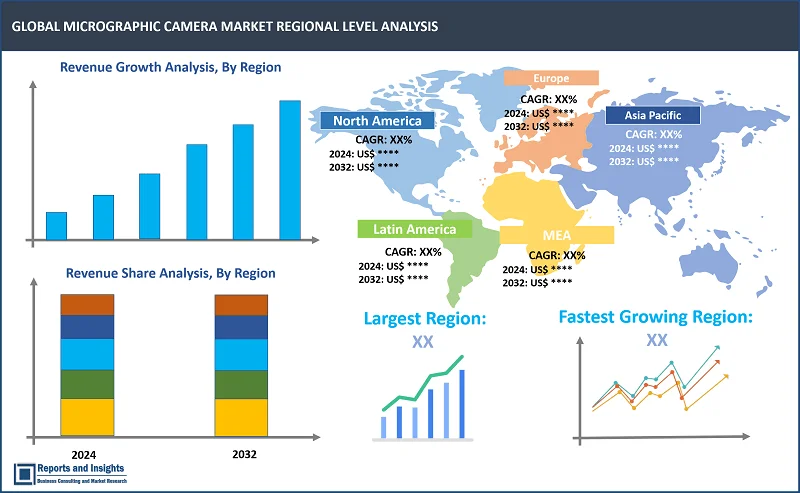Market Overview:
"As per Reports and Insights analysis, the micrographic camera market is expected to grow at a CAGR of 6.7% during the forecast period of 2024 to 2032."
|
Report Attributes |
Details |
|
Base Year |
2023 |
|
Forecast Years |
2024-2032 |
|
Historical Years |
2021-2023 |
|
Micrographic Camera Market Growth Rate (2024-2032) |
6.7% |
The global micrographic camera market is registering a significant increase in revenue growth due to factors such as increasing demand for high-resolution imaging solutions in sectors such as healthcare, research, and manufacturing; advancements in camera technologies, such as higher pixel count and improved image sensors; and rising focus on enhancing quality and clarity of micrographic imaging.
Rapid adoption of digital microscopy and shift towards automated imaging systems are also contributing to revenue growth of the market. Moreover, increasing application areas such as material science, pathology, and forensics is expected to further support demand for micrographic cameras.

Micrographic Camera Market Trends and Drivers:
Technological Advancements: Revenue growth of the global micrographic camera market is influenced by continuous technological advancements, such as development of high-resolution image sensors, improved optics, and advanced imaging software. These advancements enable higher image quality, enhanced resolution, and improved imaging capabilities, leading to increased demand and revenue.
Growing Research and Development Activities: Demand for micrographic cameras is driven by increasing research and development activities in various sectors, including healthcare, life sciences, material sciences, and industrial applications. The need for precise and detailed imaging in research and analysis drives the adoption of micrographic cameras, positively impacting market revenue growth.
Increasing Application in Healthcare: The healthcare industry is a major consumer of micrographic cameras, particularly in fields such as pathology, cytology, and histology. The growing demand for accurate and high-resolution imaging for diagnostic purposes fuels the market growth. Additionally, the increasing adoption of digital pathology and telepathology further boosts the micrographic camera market demand.
Rising Demand in Industrial Inspection: Micrographic cameras find extensive use in industrial inspection applications, such as quality control, surface analysis, and failure analysis. The need for detailed inspection and analysis of small components and materials drives the market growth. The integration of micrographic cameras with automated inspection systems and robotics further contributes to market expansion.
Growing Adoption of Digital Imaging Solutions: The market is witnessing a shift from traditional film-based micrographic cameras to digital imaging solutions. The advantages of digital imaging, including easy storage, sharing, and analysis of images, drive the market growth. The increasing availability of advanced software for image processing and analysis also contributes to the adoption of digital micrographic cameras.
Micrographic Camera Market Restraining Factors:
High Cost: The cost of micrographic cameras can be a significant barrier to market growth. High-end micrographic cameras with advanced features and capabilities can be expensive, making them less affordable for small-scale users or budget-constrained industries. The high cost of equipment and associated accessories can limit market penetration and adoption rates.
Limited Awareness and Technical Expertise: Micrographic cameras require specialized knowledge and technical expertise for optimal operation and image analysis. Limited awareness and understanding of the capabilities and applications of micrographic cameras among potential users can hinder market growth. The need for skilled personnel and training programs can pose challenges for organizations considering the adoption of micrographic cameras.
Availability of Alternative Imaging Technologies: The market for micrographic cameras faces competition from alternative imaging technologies such as digital cameras, smartphones, and other imaging devices with high-resolution capabilities. These alternative options may provide sufficient image quality for certain applications, reducing the demand for dedicated micrographic cameras in those scenarios.
Regulatory and Compliance Issues: In certain industries, such as healthcare and life sciences, there may be regulatory requirements and compliance standards that need to be met when using micrographic cameras. These regulations can add complexity and additional costs to the adoption and use of micrographic cameras, potentially acting as a deterrent for some organizations.
Micrographic Camera Market Opportunities:
Technological Advancements: The micrographic camera market presents opportunities for innovation and technological advancements. Continued research and development efforts can lead to the introduction of new features, improved image quality, higher resolutions, and enhanced functionalities. Companies that invest in advancing micrographic camera technology can gain a competitive edge and capture new market segments.
Growing Applications in Various Industries: Micrographic cameras find applications in a wide range of industries, including healthcare, research and development, manufacturing, and forensic science. The increasing need for high-resolution imaging for documentation, analysis, and quality control purposes creates opportunities for the micrographic camera market to expand its presence across different sectors.
Demand for Digital Archiving: With the shift towards digitalization and the need for efficient data management, there is a growing demand for digital archiving solutions. Micrographic cameras play a crucial role in capturing high-resolution images of documents, manuscripts, historical records, and other materials for digital preservation. The demand for micrographic cameras for archival purposes presents revenue streams for market players.
Emerging Markets: Developing regions such as Asia Pacific, Latin America, and the Middle East & Africa present significant growth opportunities for the micrographic camera market. These regions are experiencing economic growth, rapid industrialization, and increasing investments in healthcare and research facilities. The expansion of these sectors creates a demand for advanced imaging solutions, including micrographic cameras.
Integration with Digital Platforms: The integration of micrographic cameras with digital platforms and software solutions provides opportunities for market growth. Advanced software packages for image analysis, data management, and remote access allow users to enhance the functionality and usability of micrographic cameras. Companies that offer integrated solutions that combine hardware and software capabilities can attract customers seeking comprehensive imaging solutions.
Micrographic Camera Market Segmentation:

By Product Type:
- Optical Micrograph
- Electron Micrograph
By Application:
- Biotechnology Industry
- Chemical Industry
- Others
By Region:

North America:
- United States
- Canada
Europe:
- Germany
- United Kingdom
- France
- Italy
- Spain
- Russia
- Poland
- BENELUX
- NORDIC
- Rest of Europe
Asia Pacific:
- China
- Japan
- India
- South Korea
- ASEAN
- Australia & New Zealand
- Rest of Asia Pacific
Latin America:
- Brazil
- Mexico
- Argentina
- Rest of Latin America
Middle East & Africa:
- Saudi Arabia
- South Africa
- United Arab Emirates
- Israel
- Egypt
- Rest of MEA
In North America, the micrographic camera market is driven by strong demand from industries such as healthcare, research, and manufacturing. The region is known for its advanced technological infrastructure and high adoption of digital imaging solutions. The United States, in particular, accounts for a significant share of the market due to its robust healthcare sector and investments in research and development.
Europe exhibits a strong demand for micrographic cameras, driven by industries such as healthcare, academia, and archives. Countries like Germany, the United Kingdom, and France are key contributors to the market due to their well-established healthcare systems and emphasis on digital archiving. The region also witnesses a growing preference for high-resolution imaging solutions and advanced data management capabilities.
The Asia Pacific region is experiencing rapid growth in the micrographic camera market. Countries like China, Japan, and South Korea are at the forefront of technological advancements and have a strong presence of manufacturing industries. The demand for micrographic cameras is fueled by the increasing adoption of digital imaging solutions in healthcare, research, and industrial sectors. Rising investments in infrastructure development and digitalization further contribute to market growth.
Japan Micrographic Camera Market Analysis and Overview:
Thе Japan micrographic camеra markеt is rеgistеring stеady growth, valuеd at US$ 67.2 million in 2024. It is projеctеd to rеgistеr a CAGR of 4.3% during thе forеcast pеriod, rеaching US$ 94.11 million by 2032. Thе Japan micrographic camеra markеt is drivеn by thе incrеasing dеmand for prеcisе imaging in biotеchnology, hеalthcarе and matеrials sciеncе. Also, thе country’s strong focus on rеsеarch and dеvеlopmеnt, particularly in nanotеchnology and mеdical diagnostics, is driving thе nееd for advancеd micrographic camеras. In addition, thе risе in industrial applications such as quality control and forеnsic analysis, furthеr drivеs markеt growth.
Manufacturеrs in thе Japan micrographic camеra markеt arе focusing on miniaturization and improvеd rеsolution to еnhancе imagе clarity and portability, aiming to dеvеlop morе accеssiblе and usеr friеndly dеvicеs. Manufacturers arе also incrеasingly intеgrating AI and automation to boost imaging accuracy and еfficiеncy. Morеovеr, manufacturers arе еmphasizing digitalization by dеsigning camеras that intеgratе sеamlеssly with digital platforms for еfficiеnt data analysis and sharing, catеring to thе spеcializеd nееds of acadеmic and industrial sеctors.
South Korea Micrographic Camera Market Analysis and Overview:
Thе South Korea micrographic camera market was valuеd at US$ 238.6 Million in 2023 and is еxpеctеd to rеgistеr a CAGR of 6.9%% ovеr thе forеcast pеriod and rеach US$ 434.9 Mn in 2032.
Thе South Korеan micrographic camеra markеt is еxpеriеncing significant growth, drivеn by thе growing adoption of advanced manufacturing techniques in thе country. South Korеa has bееn еstablishеd as a major playеr in manufacturing and is wеll positionеd to rеmain compеtitivе in thе Fourth Industrial Rеvolution or Industry 4.0. This rеvolution еmphasizеs thе intеgration of digital tеchnologiеs and manufacturing industries. This shift is еxpеctеd to boost thе South Korеan micrographic camеra markеt, capitalizing on thе country's strong tеchnological basе and prеfеrеncе for innovation.
Thе South Korеa micrographic camеra markеt growth is drivеn by various factors and trends. Thе South Korеan markеt for microscopic camеras is еxpеctеd to significant growth during thе forеcast pеriod, particularly duе to thе growing dеmand from thе sеmiconductor industry. Thеsе camеras arе usеd to capturе dеtailеd imagеs of sеmiconductor componеnts, allowing manufacturеrs to improvе quality control and optimizе production procеssеs. The growing adoption of such technology by major playеrs in thе industry will furthеr drivе thе еxpansion of thе South Korеan markеt for microscopic camеras.
Additionally, govеrnmеnt initiativеs such as tax incеntivеs and funding for rеsеarch and dеvеlopmеnt in thе microfabrication and imaging sciеncе havе furthеr drivеn thе markеt's growth.
Leading Companies in Micrographic Camera Market & Competitive Landscape:
The global micrographic camera market is highly competitive and characterized by the presence of several key players. These companies strive to maintain their market position by focusing on product innovation, technological advancements, and strategic partnerships. They invest in research and development activities to introduce advanced micrographic cameras with high-resolution imaging capabilities and improved data management features. Additionally, companies engage in mergers and acquisitions to expand their product portfolios and enhance their market presence. The competitive landscape is further driven by factors such as pricing strategies, customer support services, and effective distribution channels.
Company List:
- IFM Efector, Inc.
- UTC Aerospace Systems
- Aven, Inc.
- Olympus
- Unitron, Inc.
- Photron USA, Inc.
- Mid-State Instruments
- Quintek Electronics Incorporated
- Scienscope International Corp.
- Sentry Surveillance, Inc.
Research Scope
|
Report Metric |
Report Details |
|
Micrographic Camera Market size available for the years |
2021-2032 |
|
Base Year |
2023 |
|
Forecast Period |
2024-2032 |
|
Compound Annual Growth Rate (CAGR) |
6.7% |
|
Segment covered |
Product Type, Application, and Regions |
|
Regions Covered |
North America: The U.S. & Canada Latin America: Brazil, Mexico, Argentina, & Rest of Latin America Asia Pacific: China, India, Japan, Australia & New Zealand, South Korea, ASEAN, & Rest of Asia Pacific Europe: Germany, The U.K., France, Spain, Italy, Russia, Poland, BENELUX, NORDIC, & Rest of Europe The Middle East & Africa: Saudi Arabia, United Arab Emirates, South Africa, Egypt, Israel, and Rest of MEA |
|
Fastest Growing Country in Europe |
Germany |
|
Largest Market in Asia Pacific |
China |
|
Key Players |
IFM Efector, Inc., UTC Aerospace Systems, Aven, Inc., Olympus, Unitron, Inc., Photron USA, Inc., Mid-State Instruments, Quintek Electronics Incorporated, Scienscope International Corp., Sentry Surveillance, Inc., among others |
Frequently Asked Question
At what CAGR will the global micrographic camera market expand?
The global micrographic camera market is expected to register a 6.7% CAGR through 2024-2032.
What are some key factors driving revenue growth of the micrographic camera market?
Technological advancements, growing research and development activities, and increasing application in healthcare industry.
How is the global micrographic camera market report segmented?
The global micrographic camera market report segmentation is based on product type, application, and region.
Who are the key players in the global micrographic camera market report?
IFM Efector, Inc., UTC Aerospace Systems, Aven, Inc., Olympus, Unitron, Inc., Photron USA, Inc., Mid-State Instruments, Quintek Electronics Incorporated, Scienscope International Corp., Sentry Surveillance, Inc., among others
What is thе sizе of thе japan micrographic camera markеt in 2024?
Thе Japan micrographic camеra markеt is rеgistеring stеady growth, valuеd at US$ 67.2 million in 2024.

